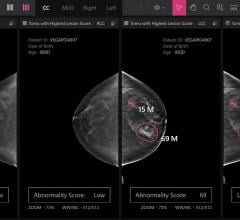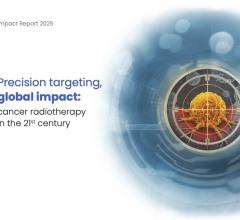August 19, 2016 — Early-stage breast cancer patients receiving a shorter course of whole breast radiation with higher radiation doses per fraction reported equivalent cosmetic, functional and pain outcomes over time as those receiving a longer, lower-dose per fraction course of treatment. These findings were derived from research from The University of Texas MD Anderson Cancer Center.
The study, published in Cancer, found patient-reported functional status and breast pain improved significantly following both radiation schedules, and there were no significant differences in physician-reported cosmetic evaluations. With a more convenient treatment schedule and equivalent outcomes, the authors suggest the shorter course as the preferred option for patients.
In the United States, women historically have been treated with conventionally fractionated whole-breast irradiation (CF-WBI), given in smaller doses over a longer period of time, rather than hypofractionated whole-breast irradiation (HF-WBI), which consists of higher doses for a shorter treatment period.
Large randomized trials from Canada and the United Kingdom have established HF-WBI as a safe and effective treatment for nearly all patients with early-stage breast cancer. In previously published research, the authors showed patients receiving HF-WBI experienced less acute toxicity and post-radiation fatigue compared to those treated with CF-WBI.
However, the adoption of HF-WBI has been limited in the United States. In fact, researchers note only one-third of patients for whom HF-WBI is currently recommended by the American Society of Radiation Oncology (ASTRO) actually receive the shorter course of therapy.
"This trial is particularly important because there is still some hesitation among clinicians in the U.S. about adopting the hypofractionated schedule," said lead author Cameron Swanick, M.D, resident, radiation oncology. "Because American patients tend to have a higher prevalence of obesity, and because prior trials excluded certain patients with high body mass index, there has been this concern that the shorter radiation treatment course may not be as safe for American patients."
For the prospective, unblinded trial, 287 women with stage 0-II breast cancer were randomized to receive either CF-WBI (149 patients) or HF-WBI (138 patients). All women also received a "boost dose," an additional treatment targeting the tumor bed with a higher dose, which has not been systematically analyzed in previous HF-WBI studies.
The trial accrued over half of its patients from the MD Anderson Cancer Network. In addition to MD Anderson, patients were enrolled from the institution's Houston-area locations, Orlando Health (formerly MD Anderson Orlando) in Orlando, Fla., and Banner MD Anderson in Gilbert, Ariz.
"This was the first investigator-initiated randomized trial conducted in the network," said Benjamin Smith, M.D., associate professor of radiation oncology. "It was a success because of the support of our partners and illustrated the potential, promise and power of our network to help achieve our mission."
All participants were at least 40 years of age and previously had been treated with breast-conserving surgery. Seventy-six percent were overweight or obese according to their body mass index. The researchers used validated tools to gather patient-reported outcomes (PROs) on cosmetic, functional and other quality-of-life measures; physicians rated cosmetic results following treatment. Assessments were performed at baseline, six months, and at one, two and three years following treatment.
"There were no significant differences between the treatment arms for any PROs at baseline, six months, one year or three years," said Swanick. "At two years, outcomes from the Functional Assessment of Cancer Therapy Breast trial outcome index were modestly higher in the hypofractionated group."
There were no significant differences in physician-reported cosmetic scores at any time point. Additionally, both patient groups reported similar improvements in breast pain and functional assessments over time.
The researchers continue to follow tumor control outcomes, though no meaningful difference in survival has been found, to date. The study has several limitations, such as a lack of complete data through three years for all patients at the time of last follow-up. All outcomes will be reported once all patients have completed three-year follow-up. Further, patients and physicians were not blinded to treatment arms, which has the potential to bias the reporting outcomes.
The results of this and previous studies further support the use of HF-WBI as the preferred radiation therapy for early-stage breast cancer patients, explained Smith. "At MD Anderson these shorter courses have become the standard of care."
Smith currently leads an ASTRO guideline panel on whole-breast irradiation, and hopes these and other data will support development of evidence-based treatment guidelines for early breast cancer.
In addition to Swanick and Smith, other MD Anderson authors include: Xiudong Lei, Ph.D., Health Services Research; Simona F. Shaitelman, M.D., Pamela J. Schlembach, M.D., Elizabeth S. Bloom, M.D., Eric A. Strom, M.D., Welela Tereffe, M.D., Wendy A. Woodward, M.D., Ph.D., Michael C. Stauder, M.D., and Thomas A. Buchholz, M.D., all of Radiation Oncology; Michelle C. Fingeret, Ph.D., Behavioral Science; and Alastair M. Thompson, M.D., Breast Surgical Oncology. Additional authors include: Tomas Dvorak, M.D., University of Florida Health Cancer Center at Orlando Health.
This work was supported by a Career Development Award from the American Society of Clinical Oncology Conquer Cancer Foundation, funded by the Breast Cancer Research Foundation.
For more information: www.onlinelibrary.wiley.com

 November 20, 2025
November 20, 2025 









